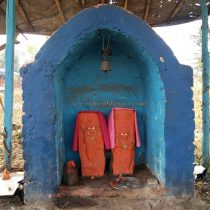NAGLE KOT
TYPE : COASTAL FORT
DISTRICT : PALGHAR
HEIGHT : 0
GRADE : EASY
Kalyan was an important port in ancient times. Ships sailed through the Arabian Sea via Ulhas Bay. Ghodbunder and Naglabunder were the ancient ports on this waterway. To protect these ports and waterways, four forts Ghodbunder, Naglabandar, Gaimukh, and Ovalekot were built to the south of Ulhaskhadi, while small forts like Nagla, Kharbaw, Firangkot, and Kambekot were build to the north of Ulhaskhadi. Nagla Kot was built on a small hill in front of Naglabandar. The fort was built by the Portuguese at the mouth of Kamwari Bay to protect Ulhas Bay. Trekkers should keep in mind that there are two forts here with similarities in their names they are Nagla Kot and Naglabunder Kot. From the Vasai-Chinchoti-Bhiwandi route, Nagla village can be reached through Nagla railway crossing.
...
Nagla village is situated on a small hill although the people of the village do not know much about this fort. If asked by the name of Old Wada or Madi, the elders of the village show the place but say that there is nothing left there today. Some people in the village also say that there is a mansion of Patil, which means that there should be a Portuguese-era administrative outpost. The remnants of Nagla Kot are still standing today. As this place is used as a garbage bin, foul smell and dirt have accumulated inside. Trees are growing on the walls of the fort as well as on the inside, the roots of which are going deep in the walls of the fort. Stone, clay, and lime are used in the construction of this fort. The fact that the building was two-storied can be seen deprived of the holes in the walls used for building the stairs, but due to dilapidation on a large scale, it is not possible to know whether it was fortified or not. Considering the available remnants, this fort should be used for storing tax collections or for surveillance purposes. The fort is small and can be seen in ten minutes. Although the fort does not exist today, its exact geographical location and strategic location on Ulhas Bay can be seen. Using small forts, watchtowers, and long-range cannons, the Portuguese established their empire on the sea lanes of the North Konkan. Originally built by the Portuguese in the 16th century, these watchtowers were mainly used to protect waterways. In 1737, in the first half of the Vasai campaign of the Marathas, this area came under the control of the Marathas and the Portuguese were permanently wiped out from this area. A person coming here with an expectation to visit a fort is likely to be upset, but you can visit this fort if you want to see the Portuguese outpost on the sea trade route and its geographical significance.
© Suresh Nimbalkar




